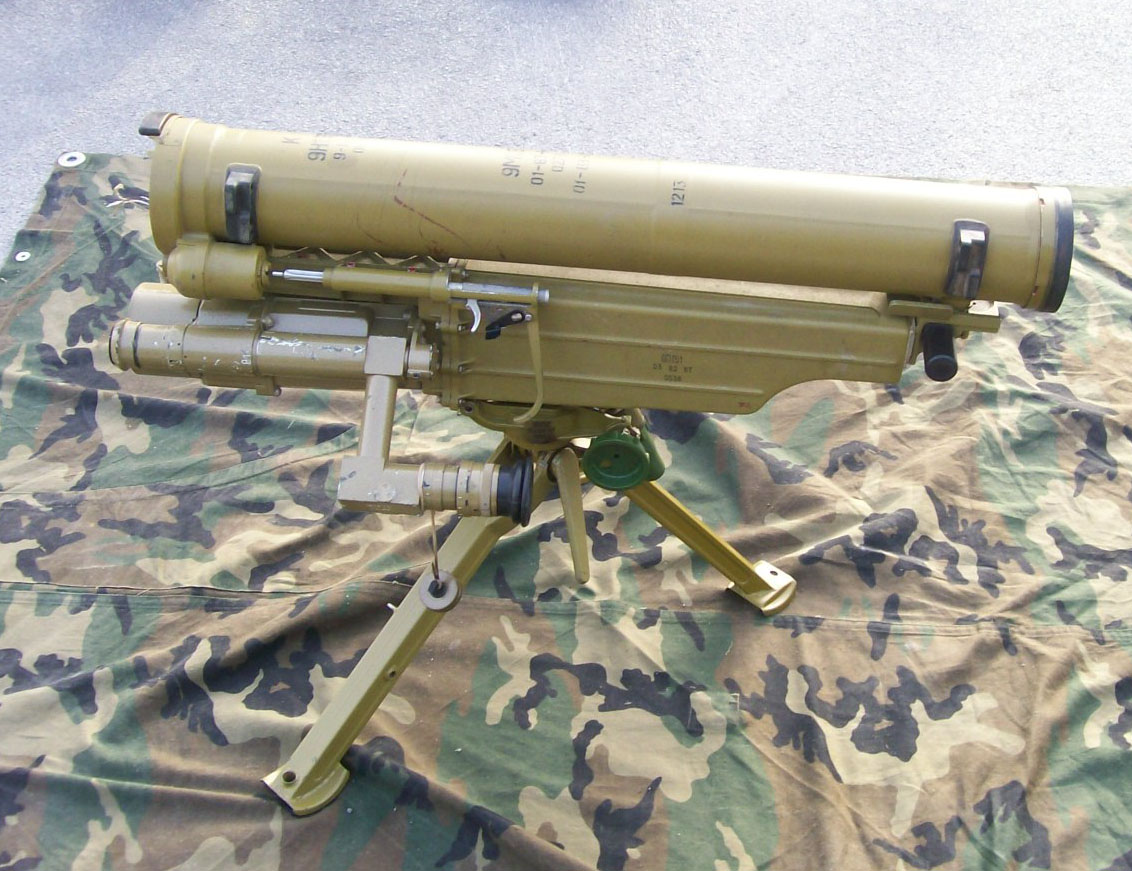AT-7 Saxhorn on:
[Wikipedia]
[Google]
[Amazon]
The 9K115 Metis (


AT-7 & AT-13 at FAS.org
{{Russian and Soviet missiles, ATM Anti-tank guided missiles of the Cold War Anti-tank guided missiles of the Soviet Union KBP Instrument Design Bureau products Military equipment introduced in the 1970s
NATO reporting name
NATO uses a system of code names, called reporting names, to denote military aircraft and other equipment used by post-Soviet states, former Warsaw Pact countries, China, and other countries. The system assists military communications by providi ...
AT-7 Saxhorn) is a man-portable, tube launched, SACLOS
Semi-automatic command to line of sight (SACLOS) is a method of missile command guidance. In SACLOS, the operator must continually point a sighting device at the target while the missile is in flight. Electronics in the sighting device and/or the ...
wire-guided anti-tank guided missile
An anti-tank guided missile (ATGM), anti-tank missile, anti-tank guided weapon (ATGW) or anti-armor guided weapon is a guided missile primarily designed to hit and destroy heavily armored military vehicles. ATGMs range in size from shoulde ...
of the Soviet Union
The Union of Soviet Socialist Republics. (USSR), commonly known as the Soviet Union, was a List of former transcontinental countries#Since 1700, transcontinental country that spanned much of Eurasia from 1922 until Dissolution of the Soviet ...
. It is considered the Soviet counterpart to the American M47 Dragon
The M47 Dragon, known as the FGM-77 during development, is an American Shoulder-launched missile weapon, shoulder-fired, man-portable anti-tank guided missile system. It was phased out of U.S. military service in 2001, in favor of the newer FGM-1 ...
ATGM.
The relatively small 9K115 missile was generally underpowered compared to contemporary armored threats, and consequently it was little-exported and little used in combat.
Development
The missile was developed by the Tula KBP. It is very similar to the 9K111 Fagot in external appearance (having three main fins); however, the missile is much lighter—primarily because of the reduced fuel load, which reduces the maximum range to . During the 1980s, an upgraded version of the missile was developed—the ''Metis-M'' 9M131 (sometimes labelled ''Metis-2''). Fired from the same launcher, the new missile is much larger and heavier, with an increased range and a larger warhead. The NATO designation for this missile is AT-13 Saxhorn-2.History
The missile was introduced into theSoviet Army
The Soviet Ground Forces () was the land warfare service branch of the Soviet Armed Forces from 1946 to 1992. It was preceded by the Red Army.
After the Soviet Union ceased to exist in December 1991, the Ground Forces remained under th ...
in 1979 to supplement the 9K111 Fagot at company level. The system is lighter than the Fagot system, due to a less complicated tripod launcher and a lighter missile.
In Russian service, the Metis is deployed with motor rifle companies, with three launchers per company. The missile is operated by a two-man team; the gunner carries the 9P151 launching post and one missile, his assistant carries an additional three missiles. The AT-7 can be operated by one man if needed.
The export prices of the missile and firing post in 1992 were:
* 9M131 Missile $13,500
* 9P151 Firing post $70,000
Models
* 9K115 (NATO: AT-7 ''Saxhorn'') – Entered service in 1979. * 9K115-2 Metis-M (NATO: AT-13 ''Saxhorn-2'')Description
The missile is fired from the 9P151 launching post, which has a simple tripod for support. It can also be fired from the shoulder, but this apparently requires more skill on the part of the operator. The launching post weighs . The missile is launched from the tube by a booster rather than the gas generator used on the 9K111 Fagot system, despite both missiles being designed by the same design bureau. The 9S816 guidance system is powered by a thermal battery attached to the launch tube shortly before launch and the missile itself is remotely powered along the guidance wires. The missile can be launched from an enclosed space, such as a building or cave, but requires at least behind the launcher, and a total internal volume of at least . The missile has a short minimum range of and can engage targets moving at up to . The missile's warhead is a singleHEAT
In thermodynamics, heat is energy in transfer between a thermodynamic system and its surroundings by such mechanisms as thermal conduction, electromagnetic radiation, and friction, which are microscopic in nature, involving sub-atomic, ato ...
shaped charge
A shaped charge, commonly also hollow charge if shaped with a cavity, is an explosive charge shaped to focus the effect of the explosive's energy. Different types of shaped charges are used for various purposes such as cutting and forming metal, ...
that can penetrate 460 mm of armor.
Operators


Current operators
* * ( Metis-M1) * * * *Hezbollah
Hezbollah ( ; , , ) is a Lebanese Shia Islamist political party and paramilitary group. Hezbollah's paramilitary wing is the Jihad Council, and its political wing is the Loyalty to the Resistance Bloc party in the Lebanese Parliament. I ...
*
*
*
*
*
*
*
**
*
*
* (Houthis
The Houthis, officially known as Ansar Allah, is a Zaydism, Zaydi Shia Islamism, Shia Islamist political and military organization that emerged from Yemen in the 1990s. It is predominantly made up of Zaydi Shias, with their namesake leadersh ...
)
Former operators
* * − 51 in 1992. *References
* * Hull, A.W., Markov, D.R., Zaloga, S.J. (1999). ''Soviet/Russian Armor and Artillery Design Practices 1945 to Present''. Darlington Productions. .External links
AT-7 & AT-13 at FAS.org
{{Russian and Soviet missiles, ATM Anti-tank guided missiles of the Cold War Anti-tank guided missiles of the Soviet Union KBP Instrument Design Bureau products Military equipment introduced in the 1970s